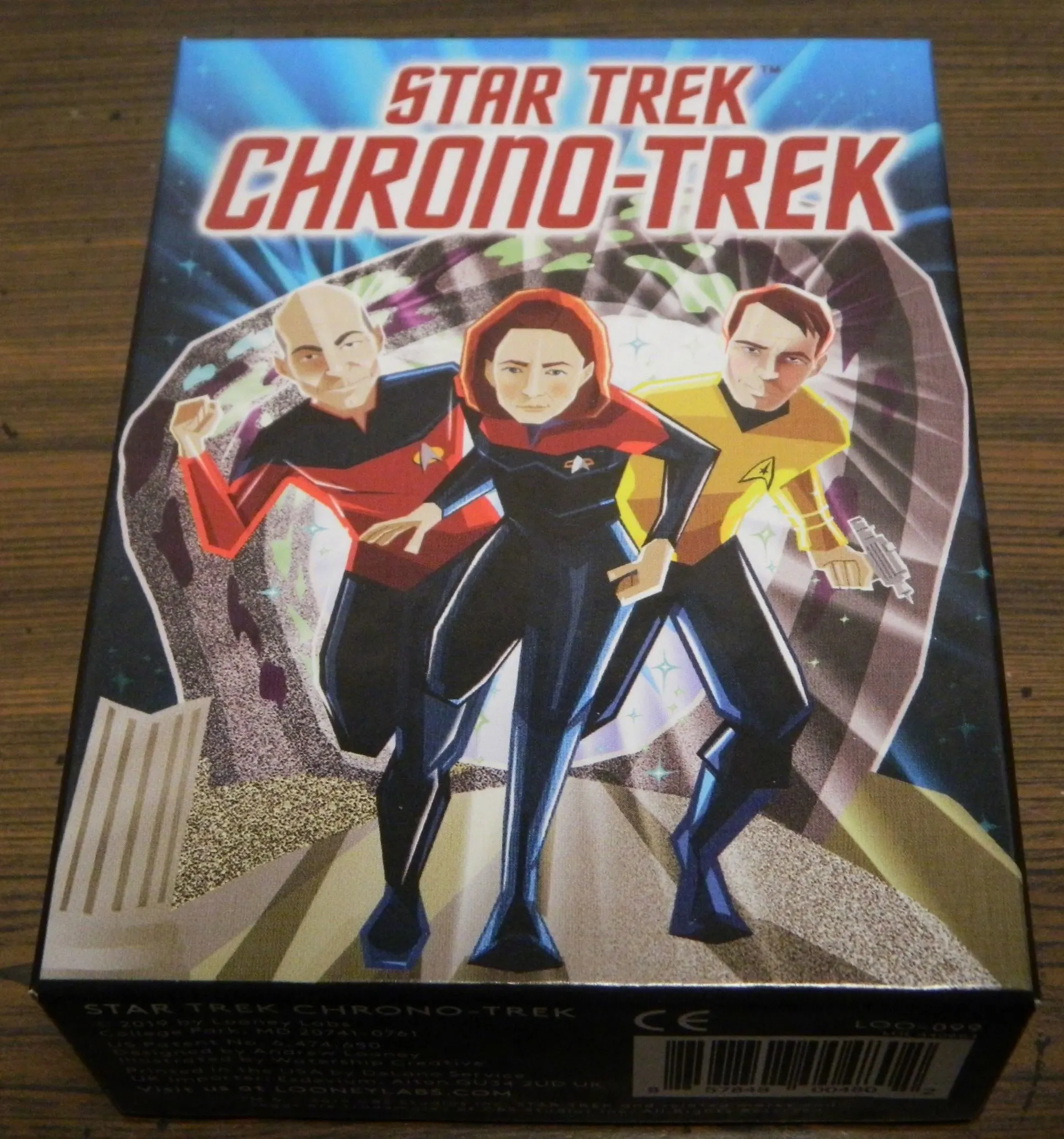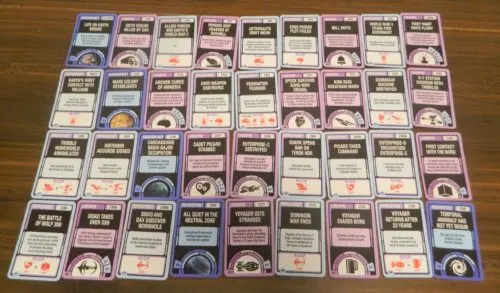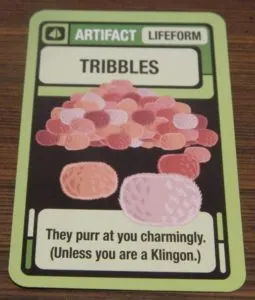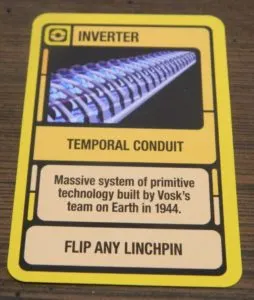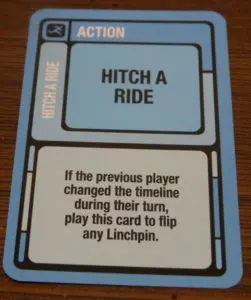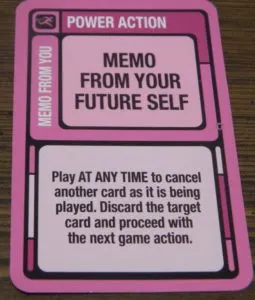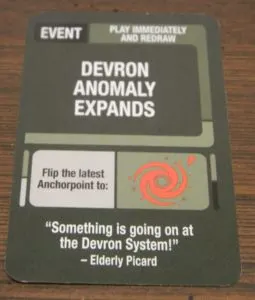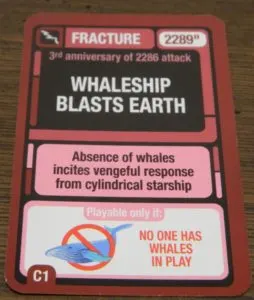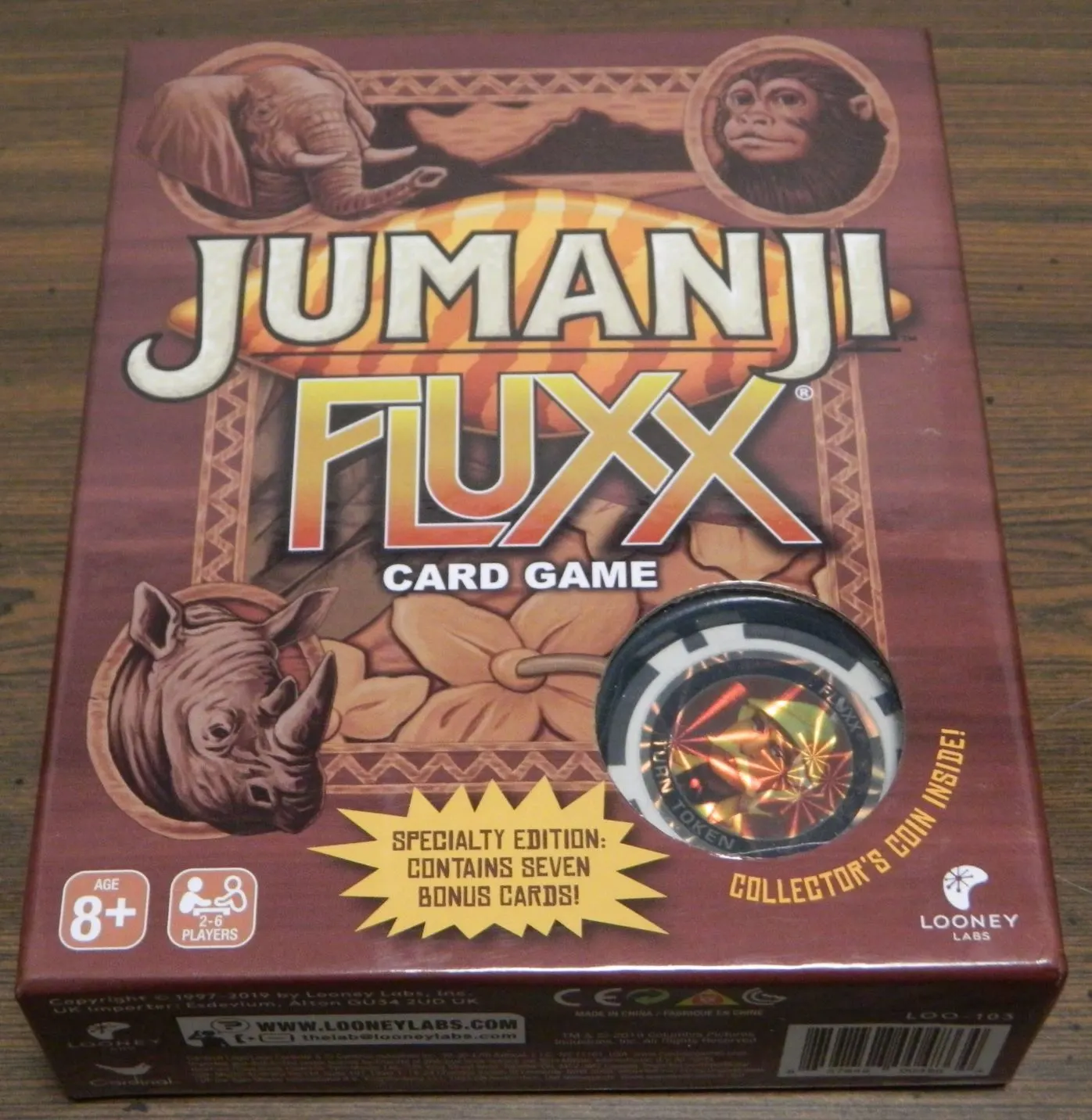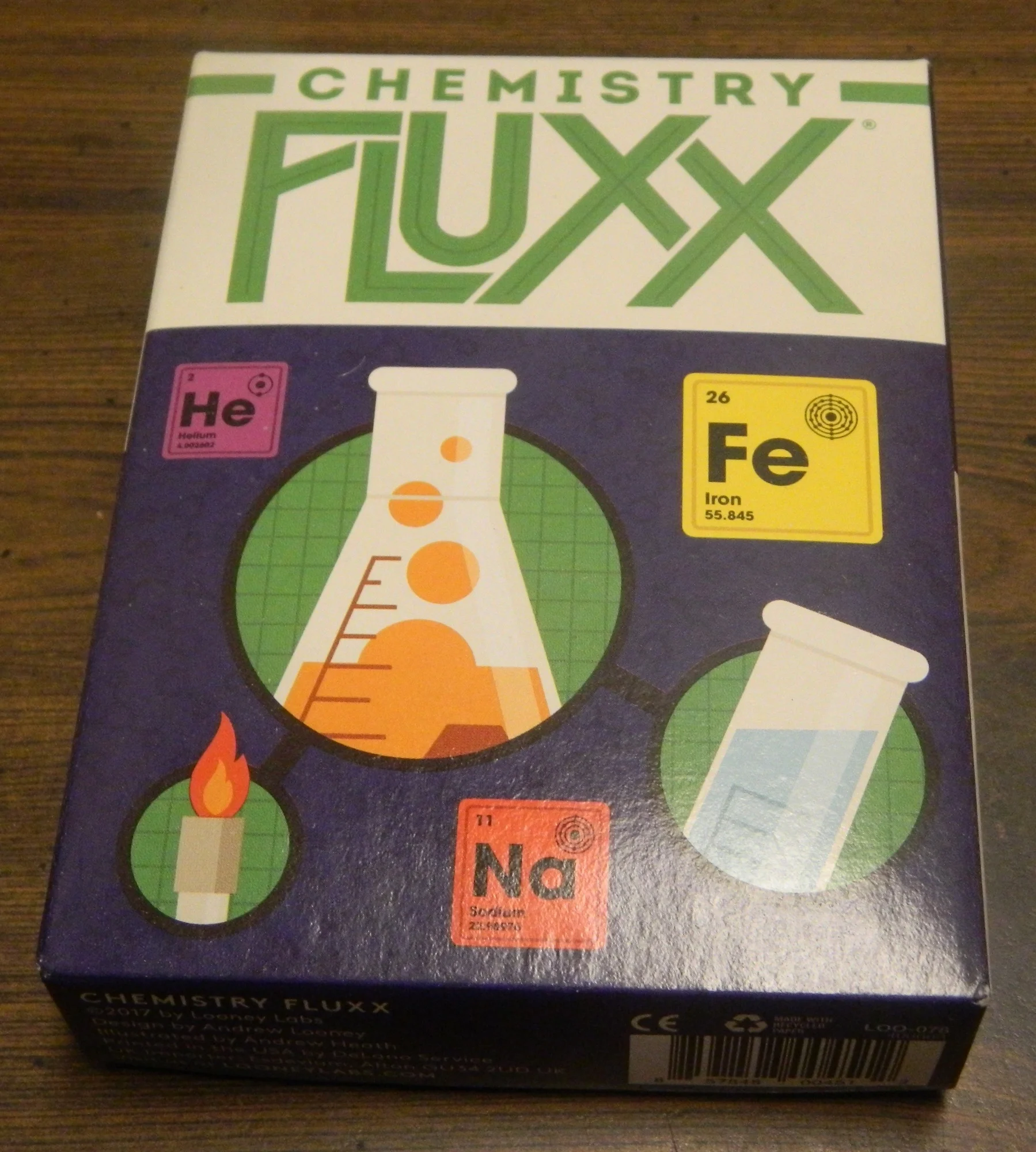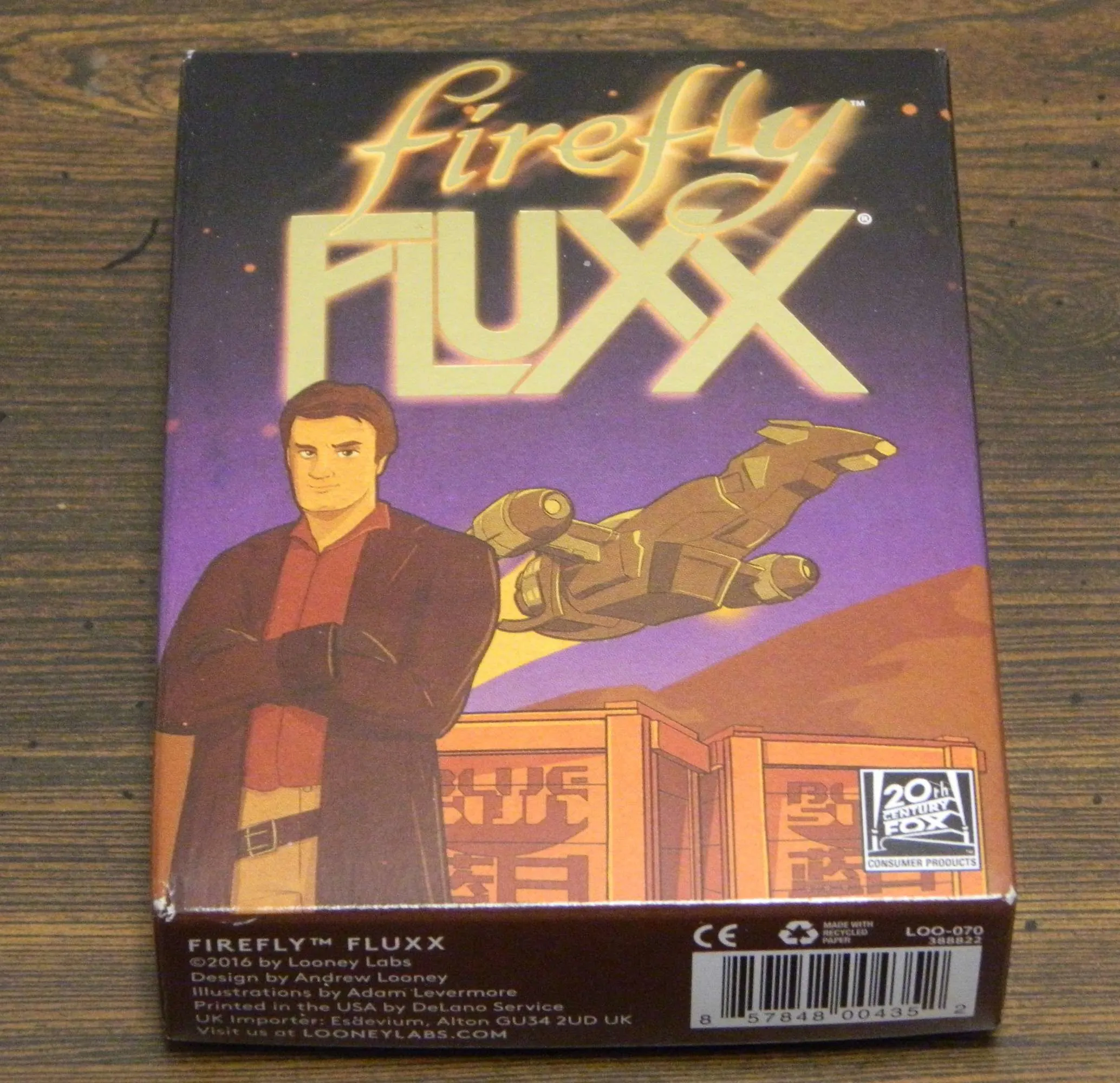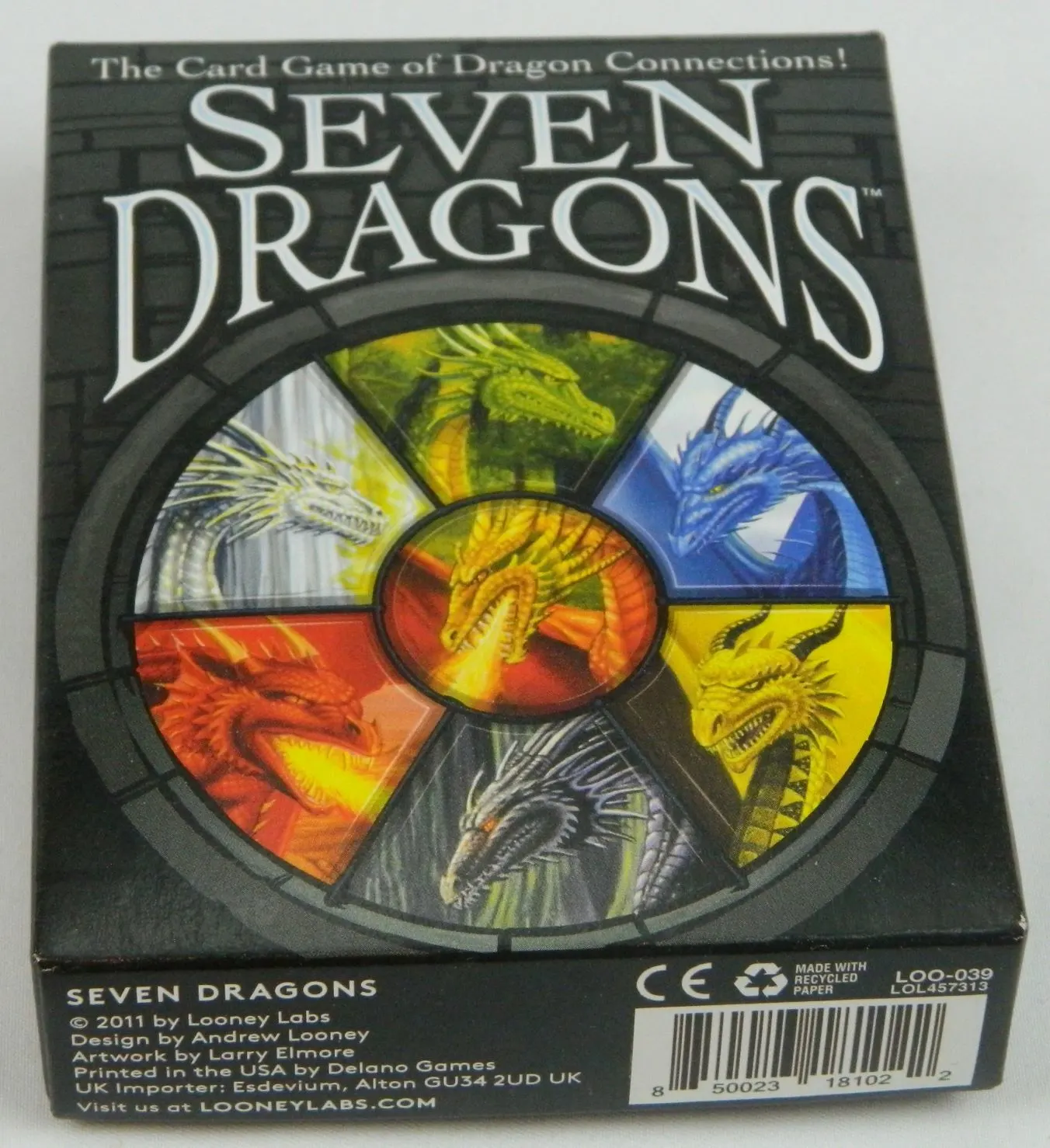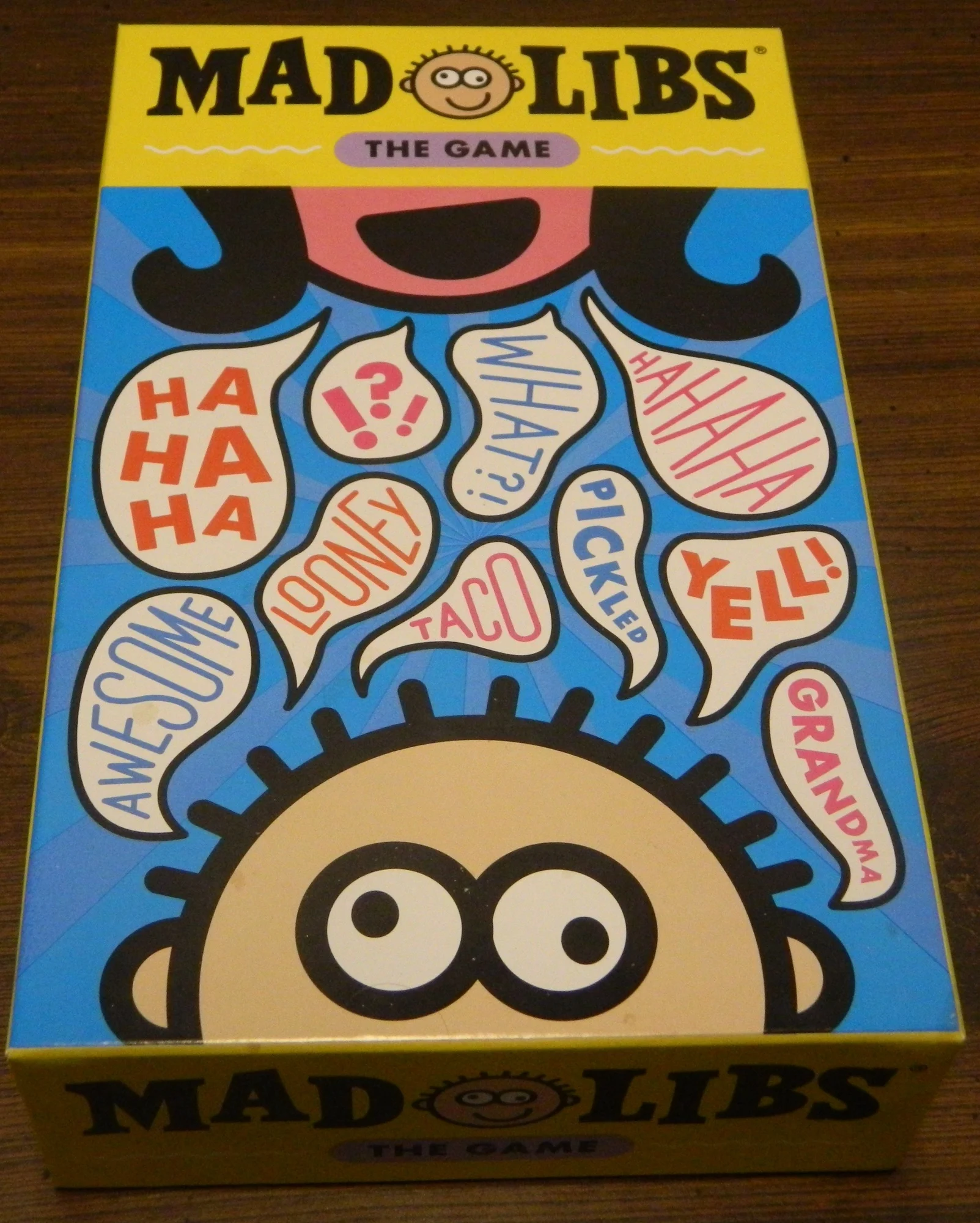Anyone that has followed our reviews here on Geeky Hobbies will know that we have looked at quite a few different Fluxx games in the past. While there are some people that don’t like the Fluxx series, I have always liked it as it is a chaotic game that always keeps you guessing. While Fluxx is obviously Looney Labs most popular franchise, Looney Labs has had a couple other popular games created over the years. One of these games was Chrononauts which was created three years after Fluxx in 2000. I had never played Chrononauts before but it was something that I wanted to try out. Well I finally got a chance to try out Chrononauts due to the recent release of Star Trek Chrono-Trek which takes the original Chrononauts and adds the Star Trek theme. Being a fan of Star Trek as well as Looney Labs other games, I was excited to try it out. Star Trek Chrono-Trek keeps all the of surprisingly fun chaos from the Fluxx series and adds time travel mechanics that while interesting don’t work quite as well as I would have liked.
We would like to thank Looney Labs for the review copy of Star Trek Chrono-Trek used for this review. Other than receiving the review copy we at Geeky Hobbies received no other compensation. Receiving the review copy had no impact on the content of this review or the final score.
How to Play Star Trek Chrono-Trek
Setup
- Separate all of the cards by their three types: Timeline, ID, and Main.
- To set up the timeline arrange the 36 Timeline cards into a 4 x 9 grid. Each Timeline card will have a letter number combination in the bottom left corner. The top row will be A1 through A9 with A1 starting on the left. The second row will be B1 to B9 following the same process. The same is done for the C and D rows. All cards in the timeline will be placed with the blue or purple side face up.
- Shuffle the ID cards and have each player take one card randomly. For your first game it is recommended you only use the cards with one dot under the character’s name. The number of dots determines the difficulty of the card. Players should keep their ID cards secret from the other players.
- Shuffle the main deck of cards and deal three cards to each player. The deck is placed face down where everyone can reach it. If the players have ID cards of different difficulties, players will adjust their number of main deck cards based on their character’s difficulty. Players with characters with a one or two difficulty will discard cards of their choice to get down to a number of cards equal to their difficulty level. Players with characters with a four difficulty will draw one more main deck card.
- If one player has an ID card more difficult than all of the other players’ ID cards, that player will start the game. Otherwise the player who has most recently watched an episode of Star Trek will go first.
The Timeline
In Star Trek Chrono-Trek the timeline is the key mechanic in the entire game. The goal of the game is to manipulate the timeline in order to get it to match your ID card. All of the cards in the timeline are one of two types: Linchpins and Ripplepoints.
Linchpin cards are key events in the timeline. Each Linchpin card is indicated by an icon along the bottom of the card that is either red or black. If the icon on the face up side is black, that is the original version of the event. The red side indicates that the event has been altered. Throughout the game you will play cards that will allow you to flip a Linchpin card. When you flip over a Linchpin card it will alter at least one Ripplepoint card. Each Linchpin card shows along the bottom of the card the Ripplepoint cards that it can affect.
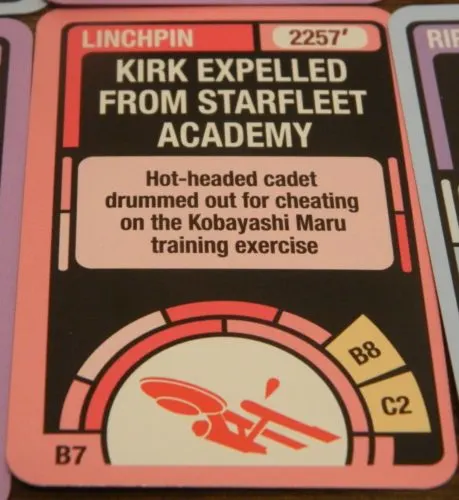
One of the players have flipped over this Linchpin card. This Linchpin card could impact the card at B8 and C2 so those two cards need to be looked at to see if they need to be flipped over.
After a Linchpin card has been flipped you will check out the Ripplepoint cards referenced on the card that was flipped. You will compare the conditions on the Ripplepoint cards to the current conditions. If the conditions are met, the Ripplepoint card is flipped over.
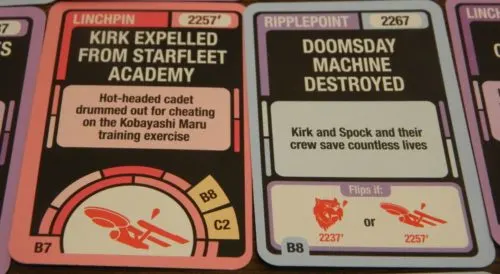
The card on the left was flipped over which potentially impacts the card on the right. As there is a red spaceship face up in the timeline the card on the right will be flipped over.
Playing the Game
On a player’s turn they will take two actions. Their first action will be to take the top card from the main deck and add it to their hand. They will then have an option for their second action:
- Play a card for its effect.
- Draw another card and add it to their hand.
After they have taken their second action play will pass to the next player clockwise.
The Cards
There are seven different types of cards in the main deck. Each of these cards have a different effect on the game.
Artifacts
When you play an Artifact card you will place it face up in front of you. Artifact cards are used for specific assignments, actions, or may be required as part of your victory conditions. Each Artifact card is a relic, tech, lifeform or beverage. This may impact whether you can use if for one of the aforementioned reasons.
Inverters
When you play an Inverter card you will have the opportunity to flip over one of the Linchpin cards in the timeline. You will also flip over any Ripplepoint cards that are impacted by the Linchpin card being flipped. Once the action has been taken the Inverter is discarded.
Actions
Action cards are played for their effect. After you have performed the action printed on the card you will discard it.
Power Actions
Power Actions are the same as action cards except they are more powerful. As they are more powerful they may have restrictions on them for you to be able to play them.
Events
Whenever you draw an event card it must be played immediately. You will take the action printed on the card. The card is then discarded. To replace the event card you drew you will get to draw another card (does not count as another action).
If a player is dealt an event card as one of their first cards, they will discard the card(s) and draw new cards. The event cards will not go into effect.
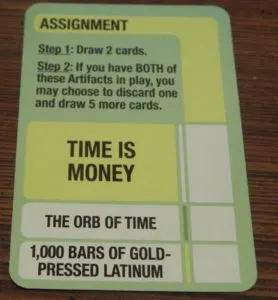
In order to play this card for its special effect you need to have The Orb of Time and 1,000 Bars of Gold-Pressed Latinum in front of you. Otherwise you will only be able to draw two cards.
Assignments
Assignment cards can be played in two different ways. The more powerful option requires you to have specific Artifacts in front of you before you play the card. If you have the Artifacts in front of you before you play the Assignment card you will get to do everything listed on the Assignment card. If you play the card but don’t have the Artifact cards, you will discard the Assignment card and draw two cards.
Fractures
Fracture cards are played directly to the timeline. Fractures have a specific place on the timeline that they have to be placed on. To play a Fracture card the requirements on the bottom of the card have to be met. If these conditions are met the card will be placed on the proper space in the timeline. You will take whatever action is listed on the Fracture card. You will also get to take a bonus card.
If you play a Fracture card but the conditions are not met, the card is discarded. If cards are played that invalidate a Fracture card, the Fracture card is discarded immediately after the card is no longer valid.
When a Fracture card is in play players cannot win the game if the Fracture occurs anytime before the key events listed on their ID card. If your character requires that Fracture card though you can still win the game.
Devron Anomaly
While most of the cards in the timeline are Linchpins or Ripplepoints, five cards in the timeline are considered Anchorpoints. These Anchorpoints can only be changed due to the growth of the temporal anomaly. Throughout the game there will be cards that extend the anomaly to additional Anchorpoints as it stretches back into time starting with the last card in the timeline. If the anomaly ever reaches the first Anchorpoint, the game will end. All of the players will lose the game except for a player with the Q ID card.
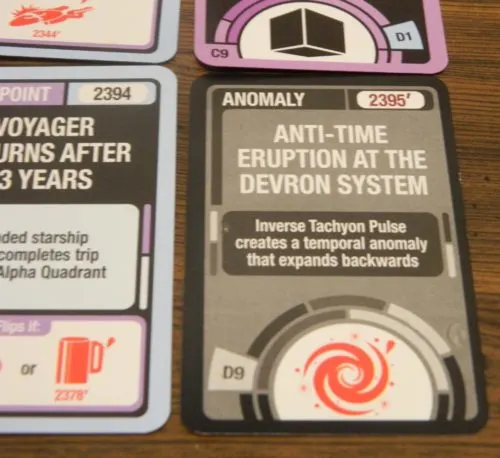
The anomaly has begun to spread. If it reaches the first card all of the players except for a player with the Q ID card will lose the game.
End of Game
In order for a player to win the game they must achieve all of the requirements listed on the bottom of their ID card. These requirements could include having certain artifacts or having certain parts of the timeline turned to a certain side.
When a player meets all of the requirements on their ID card and there are no Fracture cards in place before the events listed on the ID card, the player can potentially win the game. A player can only win on their own turn though. If you meet the requirements at the beginning of your turn you can claim victory immediately. If you make a move on your turn that wins you the game, you have to wait a while to give the other players an opportunity to play a “Memo From Your Future Self” card which lets the player who plays it undo the last card that was played. If you give the players enough time to respond and they don’t, you will win the game. If you don’t give the other players time to play a card before declaring victory, they will still have the opportunity to play the card to stop you from winning. If they don’t have the appropriate card to undo the action that won you the game, you will win the game.
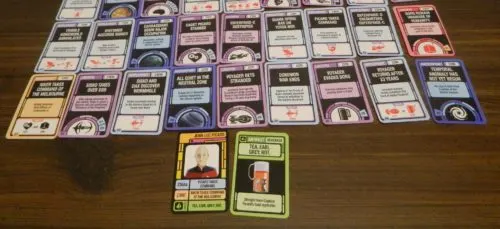
This player’s ID card was Jean-Luc Picard. In order to win the game this player needs the artifact card Tea, Earl Grey, Hot. They also need the events Picard Takes Command and Riker Takes Command of the Melbourne. As all three of these conditions have been met this player will win the game unless one of the players can play a card to reverse the last card from being played.
My Thoughts on Star Trek Chrono-Trek
As Fluxx is clearly the franchise that Looney Labs is most known for, it was very likely that I was going to bring it up while talking about Star Trek Chrono-Trek. After I played the game though the comparison between the two games was so obvious that there was no way that I couldn’t compare the two games. Honestly Star Trek Chrono-Trek feels like what you would get if you added a time travel mechanic to a game of Fluxx.
A large majority of Star Trek Chrono-Trek plays just like Fluxx. Those already familiar with Fluxx should already be quite familiar with this aspect of the game. A lot of the gameplay in Star Trek Chrono-Trek comes from drawing and playing cards in order to manipulate the current situation to fit the requirements on your own ID card. Goal cards aren’t in Star Trek Chrono-Trek but they have basically been replaced with ID cards where each player has their own goals for the game. Basically each player has to get specific artifacts in front of them (basically Keepers from Fluxx) as well as manipulate the timeline to get a couple events to match up with those on their ID card.
To accomplish this task most of the game relies on using the cards you draw in order to manipulate the current game situation to your own benefit. Unlike Fluxx you can’t directly change the rules. There is still plenty of opportunities to mess with the other players though and manipulate the game itself. The game includes a lot of cards that let you steal/trade cards with other players, search for specific cards in the discard/draw pile, and otherwise drastically change what is going on in the game. Most of the gameplay in Star Trek Chrono-Trek involves figuring out how to best use the cards in your hand to get what you want.
As you are basically drawing and playing a card every turn, it is not surprising that Star Trek Chrono-Trek is easy to play just like Fluxx. Due to the time manipulation mechanics the game is more complicated than Fluxx but the game is still pretty accessible. I would think you could explain the game to most new players within around five minutes. The game has an age recommendation of 11+ but I think kids a little younger may be able to play the game. The game is simple enough that you could play it with people that don’t generally play a lot of card/board games.
Like Fluxx Star Trek Chrono-Trek also has a pretty variable length. The game has an official length of 15 to 45 minutes and that seems pretty accurate. Anyone that has played a game of Fluxx before though should be well aware that the games can end really quickly or take quite a while. It all depends on what cards players are able to acquire and how they play them to reach their goals. You could theoretically win a game of Star Trek Chrono-Trek in two turns or it could take twenty plus turns. Based on our experiences the games seemed to end a little quicker than Fluxx but that could easily have to do with players having quite a bit of luck getting the cards that they needed.
A lot of people might be taking my comparison of Star Trek Chrono-Trek to Fluxx as an insult to Star Trek Chrono-Trek as there are a group of people that really dislike Fluxx. It is not meant to be an insult though. The game takes a lot of the elements that I like about Fluxx. The game is quite easy to play and the chaotic gameplay is interesting as things can change based on one card being played. Some might argue about this fact but I think there is a decent amount of strategy to the game. If you don’t get the right cards you have no chance of winning. There is some strategy in figuring out how to best use your cards though. If you don’t like the Fluxx series or card games that rely on a lot of luck, Star Trek Chrono-Trek won’t be for you. I had fun playing Star Trek Chrono-Trek though.
So enough about its similarities to Fluxx. Lets move onto the time traveling mechanics which is where it mostly differentiates itself. For those of you who are not aware, I have always been a huge fan of the concept of time travel. I am almost always interested in checking out any movie, TV show, or game that involves time traveling. The thing is the board/card game industry doesn’t have a strong record in this area. I can’t remember playing a board or card game that has done a good job with a time travel theme. This is why I was really interested in trying out Star Trek Chrono-Trek as I love Star Trek and time travel so I had high hopes for this aspect of the game. In action I had some mixed feelings about this part of the game.
Lets begin with the positives. In theory I actually really like the time traveling aspects of the game. Basically you play as someone who can travel through time manipulating the past to change historical events to your own liking. As changing one event in history is likely going to have ripple effects, it is not surprising that changing one event will have consequences on other events. This is the whole concept behind the time traveling aspects of Star Trek Chrono-Trek. The goal of the game is to manipulate time to benefit your own character. This means that you have to manipulate events which in turn will manipulate other events. The point of the game is finding the right events to manipulate to change history to fit the requirements on your ID card.
At first I thought this idea of one event changing another would be a pain to keep track of as it would cause a cascade effect. Star Trek Chrono-Trek does a good job managing this though. Every card in the game uses symbols and colors to represent events in the game. One color of symbol indicates that events are normal while the other represents that an event has been changed. Whenever you change one of the Linchpin cards it will reference the Ripplepoint cards that it can impact. After turning over the Linchpin card you check out the other cards that it references. To determine if these other cards should be flipped you see if the corresponding symbols are currently face up. This mechanic could have lead to disaster as there could have been a lot that you had to keep track of. Due to a smart design choice though it is surprisingly easy to determine which events are changed by each time manipulation.
This time manipulation mechanic ends up creating a little story for each game you play. It is really interesting to see how altering one event can have ripple effects throughout time. Fans of alternative histories should enjoy seeing how much you can mess up history. This works quite well with the Star Trek theme as well. The game features elements from the original five series: The Original Series, Next Generation, Deep Space Nine, Voyager, and Enterprise. While I have not seen Voyager and Enterprise yet, the game does a really good job using the Start Trek theme and shows a pretty detailed knowledge of Star Trek. Fans of Star Trek should enjoy the attention to detail. I honestly don’t think there is much more you could expect from a time traveling Star Trek card game.
I give Star Trek Chrono-Trek a lot of credit for the mechanics surrounding the time travel as they are quite clever. The problem is that the time manipulation mechanics don’t seem to come into play as much as you would expect. Maybe it was just because of our luck or how our group plays these type of games, but most games had very little time manipulation. I think this comes from a lot of the ID cards requiring players to manipulate one or zero events though. The only characters that seem to actually require a decent amount of time manipulation are the characters with the highest difficulty. In one two player game I played both players ended up getting characters that required no events to be changed. This lead to a game where the timeline was rarely manipulated.
This is a shame because I thought the time manipulation mechanics were really interesting. Unfortunately I don’t really see a lot of benefit from manipulating the timeline unless you need it for one of your goals. I ended up playing the game with a group of players that generally are pretty passive where they don’t waste time messing with other players just to mess with them. The problem is that you are kind of playing cards blindly if you do want to mess with the timeline. You have no idea what events the other players need manipulated. You could mess with an event trying to hurt other players and end up helping another player. I think the only reasons to manipulate an event that isn’t one of your goals is if you want to keep your identity secret from the other players or you know what events you have to mess with to hurt the other players. Otherwise you are better off playing a card that is going to help you out or drawing another card.
For this reason I would recommend maybe adding some rules in order to encourage players to mess with the timeline more often when it doesn’t personally benefit them. First the game should maybe let you draw a card whenever you mess with the timeline. This makes it a little more enticing to change the timeline instead of just choosing to draw another card. Otherwise the game could maybe make it easier to figure out the other player’s identity. This would make it easier to mess with the other players. For some groups you might not need any encouragement to mess with the timeline. There are going to be groups like mine though where players will rarely change the timeline unless they have to. This leads to the game not differing much from Fluxx.
Other than players not manipulating the timeline as much as I would have liked, I had some mixed feelings about the ID cards. I actually liked how the game came with quite a few different ID cards. I even like the idea of different difficulties as it lets you choose how hard/long of game that you would like to play. The problem with the ID cards is that the different difficulty levels are noticeable. When everyone is playing a card from the same difficulty level this shouldn’t be too big of an issue as cards from the same difficulty level seem to be pretty equal. When you mix up the difficulties though players with higher difficulties are going to have a hard time winning the game. The only way the game mitigates this is by giving the players with harder difficulties more cards than the other players at the beginning of the game. This advantage is wiped out quickly and then the player(s) are left at a pretty big disadvantage. For this reason I would probably recommend only playing with all of the players having characters from the same difficulty level.
I wanted to end by quickly talking about the components. There are things that I liked and didn’t like about the components. On the positive side the game comes with a lot of cards. With how games can rapidly change, it will be hard to ever have a repeat game. The game also deserves credit for the artwork as like the Fluxx series I like the game’s art style. The cards also deserve credit for being well designed. Manipulating time could have been a pain but due to smart card design it is pretty much as easy as you could expect. I had two problems with the cards though. First the ID cards reference cards in the timeline by only their date. While the timeline cards are put in chronological order, it is sometimes hard to find the card you are looking for in your first couple of games. I honestly think the cards should have also given you the letter number combinations for the event cards in the timeline. The other problem is that a lot of the cards are basically only text. I kind of wish these cards had a little more artwork on them so they didn’t feel like a wall of text.
Should You Buy Star Trek Chrono-Trek?
Having never played Chrononauts before I didn’t know what to expect out of Star Trek Chrono-Trek. Being a fan of Star Trek and Fluxx I had high hopes for the game. After playing the game it was hard not to see the similarities between Star Trek Chrono-Trek and the Fluxx series. Both games utilize the simple draw and play mechanics where each card play can change a lot about the game. This adds a lot of luck to the game but there is some strategy as you figure out how best to utilize your cards. The one area where Star Trek Chrono-Trek differs from Fluxx though is how you can manipulate the timeline. In theory I really liked this mechanic as it is pretty straightforward and quite clever. The problem is that in a lot of games there isn’t much need to make many changes to the timeline. This leads to the game basically playing like Fluxx. Star Trek Chrono-Trek is still fun but it could have been better if there were more reasons to mess with the timeline.
If you aren’t really a fan of card games that are kind of random/chaotic (basically Fluxx) or aren’t a fan of Star Trek, I don’t think you will like Star Trek Chrono-Trek. If you don’t mind a little randomness though and are a fan of the Star Trek franchise, I think you will have some fun with Star Trek Chrono-Trek and should consider picking it up.
If you would like to purchase Star Trek Chrono-Trek you can find it online: Amazon, looneylabs.com

